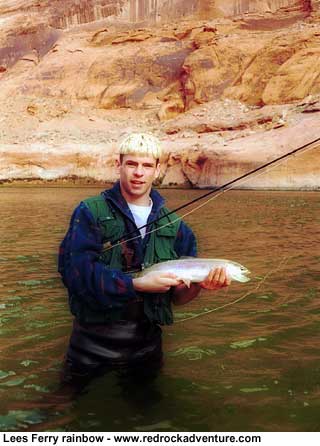 By Sam Webb
By Sam Webb
It was not quite six o-clock in the morning, Saturday, January 17th. The weatherman had predicted a major snowstorm for Monday but other than a few high clouds partially obscuring the moon, there was no indication of the impending storm.
I kept out off the way as the boat was backed down the ramp, splashed into the water and floated free of its trailer.
Jeff Chapman, one of the owners of the Red Rock Fly Shop in St. George, guided the boat onto the sandy beach next to the ramp and we all climbed aboard.
One of the best places to fish is on the massive gravel bar at the power lines, almost 14 miles up the river. To fish there, we had to get there before anyone else and that's why we launched the boat in the dark. As we pulled away from the ramp I could see a string of headlights coming down the road. Ours was the first boat on the river.
It was getting light fast now, light enough for Jeff to see the river channel and the massive cliffs on both sides. Jeff swung the boat into the current and with a roar the 200 horsepower jet engine propelled us into the narrow gorge.
Now my concern was that Jeff really knew the river as well as he said he did. It was still mighty dark and we were flying up the river, around bends and past sand bars and rocks at breakneck speed.
The wind from the speeding boat was cold, real cold and I was glad I had remembered my heavy coat, wool gloves and stocking hat. By the time I got settled into my seat and started to relax, the ride was over. As the boat slowed and then ran aground on the gravel bar Jeff commented on how low the river was. "If I had known the river was this low I would have stayed closer to the main channel and not cut some of those corners so tight."
It wasn't so bad hearing him talk now that we were safely on the gravel bar. Still, I wondered how close we had come to hitting something. Only then did they tell me that the flat bottomed boat could run in as little as 10 inches of water.
 Within another hour the boat traffic was unbelievable. I had no idea there would be so many boaters zipping up and down the river in the middle of the winter.
Within another hour the boat traffic was unbelievable. I had no idea there would be so many boaters zipping up and down the river in the middle of the winter.
As the gibbous moon set and the high clouds turned pink with the rising sun, we rigged our fly rods and got serious about the fishing.
I tied on a root beer colored wooly bugger with lots of sparkle, weighted it with a BB sized split shot (floating line, 8 foot, 4X, tapered leader) and started fishing where the main current cut across the top of a large, slowly spinning pool of water.
I cast into the current, let the bugger dead drift until it slowed down and started to swing into the pool. I then began a slow retrieve.
Immediately I had a strong hit, raised the rod tip and the fight was on. In another minute or two I landed my first Colorado River rainbow. It was about 16 inches long, fat and beautifully colored with deep red along its flanks.
I caught five more rainbows on the wooly bugger using the same technique without moving five feet up or down the river.
I surveyed the other fishers to see what they were using and how effective it was. The rainbows were spawning and several were dead drifting a San Juan worm with an egg pattern dropper.
Others were fishing with scuds (there were scuds everywhere and some of them were huge, almost three fourths of an inch long.) Everyone caught fish, lots of fish. Most were between 14 and 18 inches long.
About noon a midge hatch came off and the fishing ground to a halt as the rainbows switched over to midges. Midges were coming off so fast they began to form rafts and soon the rainbows were porpoising by the hundreds.
It was fun to watch but extremely frustrating. I tied on a size 22 midge imitation but it was still way too big and I didn't get a look. I tried everything I could think of and never got a single take. I finally switched over to a light green scud and gave up on the hatch.
Just over an hour later the hatch was over, the midges were gone and the rainbows switched back to other food sources. The fishing immediately picked up.
I wanted to get some pictures of the canyon while the light was still good so at about 4 pm we packed our gear into the boat and headed back toward Lees Ferry. I was surprised to see that a boat and several anglers occupied every single bar, shallow run or other wadable area.
I was told that the boat traffic is considerably less during the week and generally it is better to plan a trip then, if possible.
Right now (late winter and early spring) is the best time to fish the Colorado at Lees Ferry. Fishing remains good throughout the year but the summer is so hot (commonly above 100 degrees) that it just isn't as much fun.
We stayed overnight at the Marble Canyon Lodge, right on Highway A89 and just a few feet from the turnoff to Lees Ferry. The rooms were modest but clean and they even had TVs, although there were only three stations available for viewing (not that it mattered because I don't know anyone that drives all the way to Lees Ferry to watch TV). Give the Marble Canyon Lodge a call at 1-800-726-1789 for reservations or information.
If you are looking for an excellent dinner before, after or during your trip to Lees Ferry, stop in at the Vermillion Cliffs Bar and Grille, several miles west of the Lees Ferry turnoff, on Highway A89 in the small town of Vermillion Cliffs. The food is good, there is lots of it and the prices aren't bad either.
